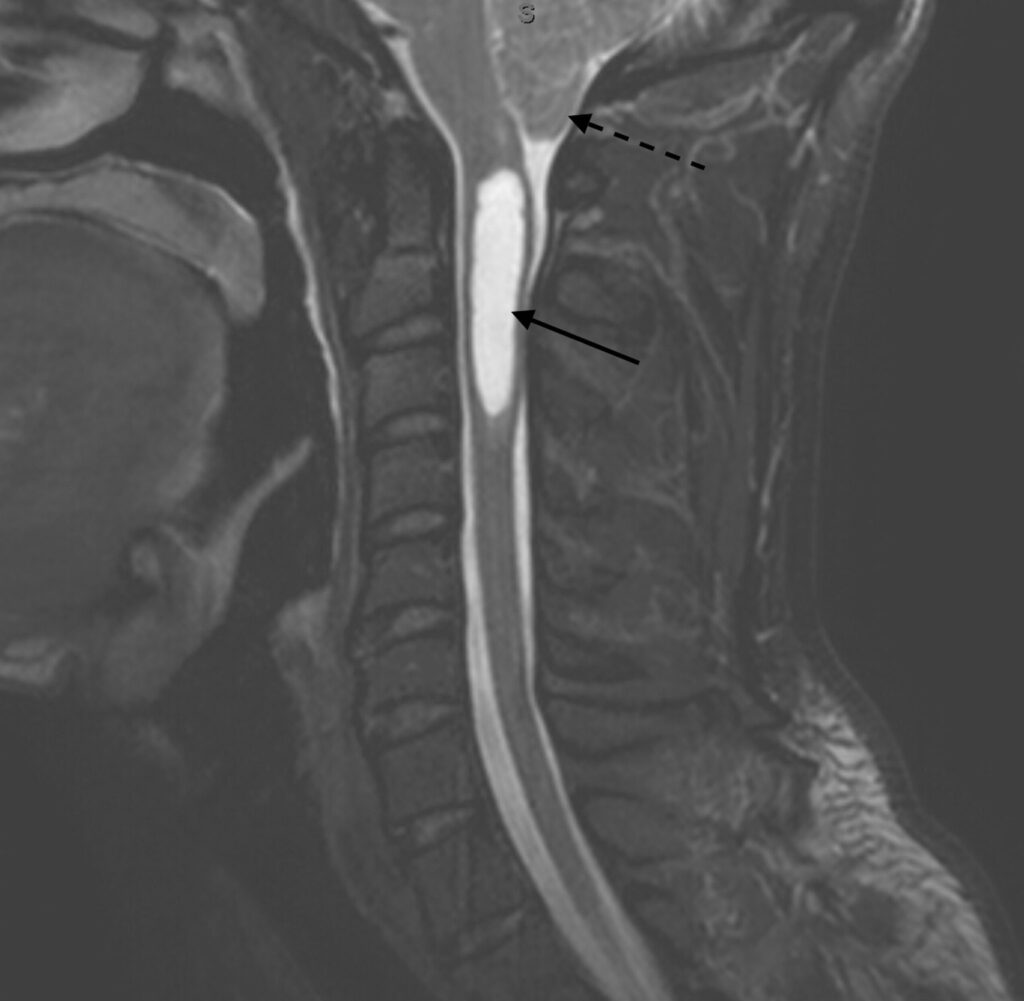Syringomyelia

What’s Syringomyelia?
The medical term ‘Syringomyelia’ refers to a condition that occurs when a fluid-filled cyst forms within the spinal cord. The cyst also referred to as a syrinx contains a fluid known as cerebrospinal fluid. The cerebrospinal fluid refers to a clear fluid that encompasses and protects the brain and spinal cord. A syrinx forms when the cerebrospinal fluid accumulates due to any obstruction within the spinal cord. Enlargement of a syrinx over time can lead to pain, stiffness, and irreversible damage to the spinal cord.
Although several conditions can lead to syringomyelia, most cases of syringomyelia occur due to a chronic disorder known as Chiari malformation, a condition where brain tissue extends into the spine. Syringomyelia tends to affect individuals between the ages of 30 and 50.
What’s the Symptoms of Syringomyelia?
The symptoms of syringomyelia usually develop over time and may worsen when left untreated. The symptoms also depend largely on the location, size, and extent of the syrinx. The most common symptoms of syringomyelia may include:
- Headaches
- Muscle weakness and atrophy in the back, arms, or legs
- Muscle stiffness especially in the back and shoulders
- Abnormal curvature of the spine
- Pain in the back, neck, and shoulders
- Cervical radiculopathy
- Numbness, tingling, or burning sensations in the back, arms, or legs
- Loss of sensitivity to pain in the upper extremities
- Bowel or bladder incontinence
The less common symptoms of syringomyelia may include paralysis, involuntary muscle contractions, and uncoordinated body movements.
What’s the Causes of Syringomyelia?
Most cases of syringomyelia occur due to a disorder known as Chiari malformation. Chiari malformation refers to a congenital defect that occurs when a portion of brain tissue protrudes into the spinal canal thereby obstructing the normal flow of cerebrospinal fluid between the brain and the spinal cord. Other conditions that may lead to syringomyelia include:
- Meningitis
- Spinal cord injuries
- Spinal tumors
- Inflammation of the spinal cord covering (Arachnoiditis)
- Congenital disorders such as Myelomeningocele and Tethered cord syndrome
How do Spinal Specialists Diagnose Syringomyelia?
Along with a detailed medical history, a spinal specialist will perform a physical examination to review the patient’s neurological functioning. The specialist will then order some imaging tests to provide a final diagnosis. Diagnostic tests for syringomyelia may include:
- Magnetic Resonance Imaging (MRI) scans of the brain and spine to check for the presence of a syrinx or any other abnormal growth
- CT scans to check for other spinal abnormalities in the case where MRI scans do not detect a syrinx in the spinal cord
- Radiography
How do Spinal Specialists Treat Syringomyelia?
The treatment options for syringomyelia largely depend on the symptoms and progression of the disorder in a patient. An individual may not require any treatment in the case where the symptoms experienced do not negatively impact daily activities. A spinal specialist may recommend non-surgical treatment options such as physical therapy or over-the-counter medications to relieve pain.
The use of surgical procedures to treat syringomyelia may occur in cases where the symptoms experienced negatively impact the patient’s life. Surgical procedures for syringomyelia such as Chiari decompression aim to directly drain the syrinx and restore normal movement of cerebrospinal fluid between the brain and spinal cord.
What’s the Possible Complications of Surgical Treatment for Syringomyelia?
Surgical treatments may not provide permanent relief for symptoms in some cases of syringomyelia. Possible complications of surgical treatment for syringomyelia may include hemorrhage, difficulty in walking, spinal cord injuries, and recurrence of the syrinx after drainage.
References
National Organization for Rare Disorders. Syringomyelia. (https://rarediseases.org/rare-diseases/syringomyelia/)
Syringomyelia information page. National Institute of Neurological Disorders and Stroke. https://www.ninds.nih.gov/disorders/All-Disorders/Syringomyelia-Information-Page.
Syringomyelia. Genetic and Rare Diseases Information Center. https://rarediseases.info.nih.gov/diseases/7725/syringomyelia
Conditions – Syringomyelia. American Syringomyelia & Chiari Alliance Project. https://asap.org/index.php/disorders/syringomyelia/
Gautam J, et al. (2020). Syringomyelia as a delayed complication of lumbar–sacral adhesive arachnoiditis in Pott’s disease.
casereports.bmj.com/content/13/5/e234032
